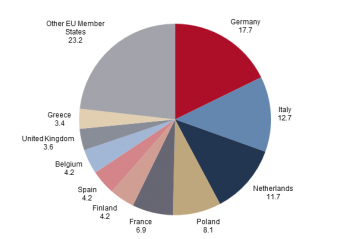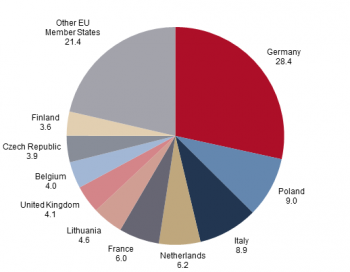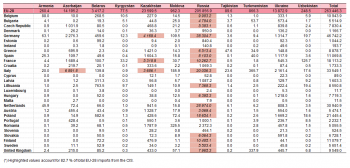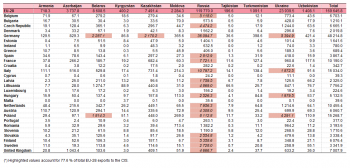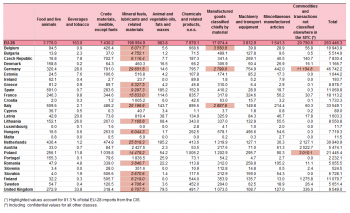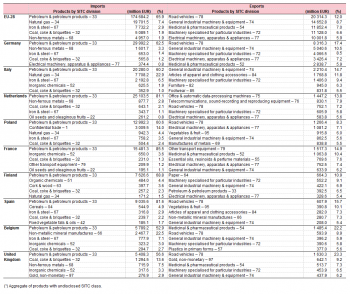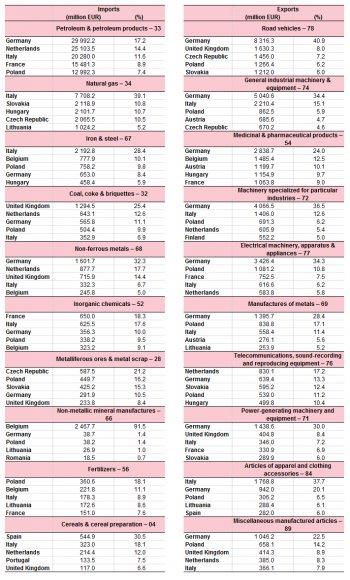Archive:EU-Commonwealth of Independent States (CIS) - statistics on international trade by EU Member State
This Statistics Explained article is outdated and has been archived - for recent articles on non-EU countries see here.
- Data extracted in October 2014. Most recent data: Further Eurostat information, Main tables and Database. No planned update.
This article is part of an online publication EU-Commonwealth of Independent States (CIS) - statistical overview (archived) and focuses on the external trade relations between the EU-28 Member States and the Commonwealth of Independent States (CIS) countries. Due to the dominant role of Russia in the CIS (in 2013 78.1 % of EU-28 imports from the CIS stemmed from Russia and 70.6 % of EU-28 exports to the CIS ended in Russia), most of the relations examined are not broken down by CIS country. In such cases, the CIS aggregate is considered.
Main statistical findings
Trade relations between EU-28 Member States and the CIS
Germany was the most important trade partner to the CIS; Italy, the Netherlands and Poland followed
In 2013, EU-28–CIS trade (EUR 433 billion) made up 13 % of the total extra-EU trade. Imports from the CIS represented 15.7 % of the extra-EU imports and the EU exports to the CIS made up 9.8 % of the total extra-EU exports. In order to identify the most important trade partners to the CIS among the EU-28 Member States, EU-28 imports from the CIS and EU-28 exports to the CIS are broken down by Member State.
Figures 1 and 2 illustrate that four EU-28 Member States (Germany, Italy, the Netherlands and Poland) were involved in more than half of the value for both trade flows between the EU-28 and the CIS, while Germany accounted for 17.7 % of EU-28 imports (EUR 46.7 billion) from the CIS and 28.4 % of EU-28 exports (EUR 48.2 billion) to the CIS. France, Finland, Spain, Belgium and the United Kingdom were also significant trade partners.
The EU-28 presented a trade deficit (EUR – 93.8 billion), which was the case for all major EU Member States traders except for Germany (exports to the CIS exceeded imports from the CIS by EUR 1.5 billion).
The share of imports from the CIS (or exports to the CIS) in the total value of imports (or exports) performed by a country is a measure of trade dependency to the CIS. As far as the share of imports from the CIS was concerned (Figure 3), Lithuania was by far the most dependent EU-28 Member States (32.3 % of total imports), followed by Bulgaria (21.3 %), Finland and Greece (19.0 % each). The CIS also accounted for the 31.6 % of exports from Lithuania and 21.4 % of exports from Latvia (Figure 4).
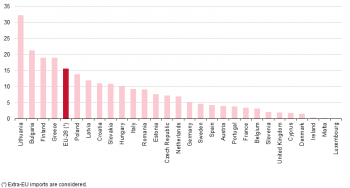
(%)
Source: Eurostat (ext_lt_intertrd) and COMEXT (DS-018995)

(%)
Source: Eurostat (ext_lt_intertrd) and COMEXT (DS-018995)
External trade relations at country level
EU-28 exports to the CIS were more diversified than imports; Russia led in both trade flows
Russia accounted for 78.1 % of the total EU-28 imports from the CIS (EUR 205.9 billion) and 70.6 % of total EU-28 exports to the CIS (EUR 119.8 billion). Consequently, the majority of significant trade relations between the EU-28 and the CIS at country level involved Russia (Tables 1 and 2).
According to Table 1, 51.9 % of total EU-28 imports from the CIS were performed solely between seven EU-28 Member States (Germany, the Netherlands, Italy, Poland, Finland, France and Belgium in descending order of trade value) and Russia. France, Germany and Italy also presented significant imports from Kazakhstan (55.8 % of all EU-28 imports from Kazakhstan), while Italy accounted for 48.6 % of EU-28 imports from Azerbaijan.
Table 2 shows that EU-28 exports to the CIS at country level were generally more diverse than the imports, even though 21.3 % of the total EU-28 exports to the CIS were performed between Germany and Russia. Ukraine was an important EU-28 exports destination (EUR 23.9 billion), with Germany, Poland, Hungary and Italy contributing 56.6 % of the total EU-28 exports to Ukraine. Germany also accounted for 26.6 % of EU-28 exports to Belarus and 29.0 % of EU-28 exports to Kazakhstan, while Poland accounted for 21.1 % of total EU-28 exports to Belarus.
Commodities traded between EU-28 Member States and the CIS
The EU-28 imported mineral fuels from the CIS and exported machinery and transport equipment, chemicals and other manufactured goods
Mineral fuels, lubricants and related materials (SITC Section 3) imported by Germany, the Netherlands, Italy, France, Poland, Spain, Greece and Estonia made up 53.1 % of the total EU-28 imports from the CIS (Table 3). The share of these goods on total EU-28 imports from the CIS was 75.5 %. Commodities and transactions not classified elsewhere in the SITC (SITC Section 9) were the second most common class of commodities imported from the CIS (7.9 % of the total EU-28 imports from the CIS, 4.2 % for Germany solely and 1.1 % for Poland). Belgium, Italy and Germany also imported significant amounts of manufactured goods classified chiefly by material (SITC Section 6) from the CIS.
EU-28 exports to the CIS were diversified among SITC commodity classes as they were among EU Member States. Machinery and transport equipment (SITC Section 7) was the most common commodity class exported to the CIS (45.4 % of total EU-28 exports to the CIS, 15.8 % for Germany solely, Table 4), while chemicals and related products (SITC Section 5), miscellaneous manufactured articles (SITC Section 8) and manufactured goods classified chiefly by material (SITC Section 6) were also relevant exports (17.0 %, 11.8 % and 11.3 % of total EU-28 exports to the CIS respectively). Germany and Poland were major suppliers of all of these four commodity classes and also presented significant amounts of exports of food and live animals (SITC Section 0) to the CIS.
Most common products traded between EU-28 Members States and the CIS
Products exported to the CIS were far more diverse than the products imported
Table 5 shows that the share of petroleum and petroleum products (SITC division 33) in the total EU-28 imports from the CIS for the major trading EU-28 countries ranged from 52.9 % (Belgium) to 85.5 % (France). Other products represented significant shares of their total imports from the CIS for specific EU Member States, namely natural gas for Italy (22.9 %, SITC Code 34), non-metallic mineral manufactures for Belgium (22.5 %, SITC Code 66) and coal, coke and briquettes for the United Kingdom (13.6 %, SITC Code 32).
It is evident that EU-28 Member States exported various products to the CIS countries. The distribution of the main exports for the EU-28 as a whole was quite similar to that for Germany, while for the rest of the major trade partners there was a greater variety. Among others, Italy and Spain exported articles of apparel and clothing accessories (11.8 % and 7.3 % of their exports to the CIS respectively, SITC Code 84), the Netherlands exported office and automatic data-processing machines as well as telecommunications, sound-recording and reproducing equipment (13.8 % and 7.9 % respectively, SITC Codes 75 and 76), France exported essential oils, resinoids and perfume materials (7.6 %, SITC Code 55), Finland exported paper (10.9 %, SITC Code 64) and the United Kingdom exported non-monetary gold (9.2 %, SITC Code 97).
Table 6 shows that 39.1 % of the natural gas and 28.4 % of iron and steel (SITC Code 67) imported from the CIS by the EU-28 was destined to Italy. Germany accounted for 32.3 % of the EU-28 imports of non-ferrous metals (SITC Code 68) and Belgium accounted for 91.5 % of the EU-28 imports of non-metallic mineral manufactures from the CIS, while the United Kingdom accounted for 25.4% of coal, coke and briquettes imports (SITC Code 32) and Spain for 30.5% of cereals and cereal preparation imports (SITC Code 04).
As far as EU-28 exports to the CIS were concerned, Germany led the exports for the most common products, with the exceptions of articles of apparel and clothing accessories (Italy led with 37.7 % of total EU-28 exports to the CIS, Germany followed with 20.1 %) and telecommunications, sound-recording and reproducing equipment (the Netherlands led with 17.2 %, Germany followed with 13.3 %).
Data sources and availability
All data presented in this publication were taken from COMEXT, Eurostat’s database containing statistics on trade in goods. These data may differ from those produced by the national statistical services of the countries of the Commonwealth of Independent States (CIS) and provided by the Interstate Statistical Committee of the CIS (CIS-STAT).
Methodology / Metadata
In the methodology applied for statistics on the trading of goods, extra-EU trade (trade between EU Member States and non-member countries) statistics do not record exchanges involving goods in transit, placed in a customs warehouse or given temporary admission (for trade fairs, temporary exhibitions, tests, etc.). This is known as ‘special trade’. So the partner will be the country of final destination of the goods.
Dutch imports from CIS partners are over-estimated because of the ‘Rotterdam effect’ where goods destined for the rest of the EU arrive, and are therefore recorded in harmonised EU external trade statistics, in Dutch ports. This then has a negative effect on the imports from the CIS partners of those EU Member States to which the goods are re-exported as these shipments would be recorded as intra-EU imports from the Netherlands rather than extra-EU imports from the CIS partners. To a lesser extent, Belgian trade figures are similarly over-estimated.
Information on commodities exported and imported are presented according to the Standard international trade classification (SITC) at a more general level (1-digit — Tables 3 and 4) and a more detailed level (2-digit — Tables 5 and 6).
Some products classified under SICT 9 are subject to confidentiality: in order to suppress the nature of the commodity involved, all or part of the trade is allocated to a confidential product code.
In this statistical article: 1 billion = 1 000 000 000, 1 million = 1 000 000.
- International trade in goods (ESMS metadata file — ext_go_esms)
Context
The Commonwealth of Independent States (CIS) has become a significant trading partner of the EU-28 in recent years, with imports and exports growing from EUR 130 billion in 2002 to EUR 434 billion in 2013 (+ 195 %). In 2013 EU-CIS trade represented 13 % of all EU trade (intra-EU and extra-EU), while in 2002 the share was 7 %.The trade balance has been negative since 2002, and it has been increasing, with the EU having imported EUR 94 billion from the CIS, more than it exported in 2013.
EU imports from the CIS represented 16 % of all extra-EU imports and EU exports to the CIS amounted to 10 % of total extra-EU exports.
Russia has a dominant position amidst the CIS countries and represents the lion’s share of both EU-CIS imports (78 %) and EU-CIS exports (71 %).
See also
Further Eurostat information
Publications
Main tables
- International trade, see:
- International trade data (t_ext)
- International trade long-term indicators (t_ext_lti)
- International trade short-term indicators (t_ext_sti)
Database
- International trade, see:
- International trade detailed data (detail)
- EU trade since 1988 by SITC (DS-018995)
Dedicated section
Source data for tables and figures (MS Excel)
External links
- Interstate Statistical Committee of the CIS
- ISIC rev.4 classification
- DG Trade — policy — countries and regions — Russia
